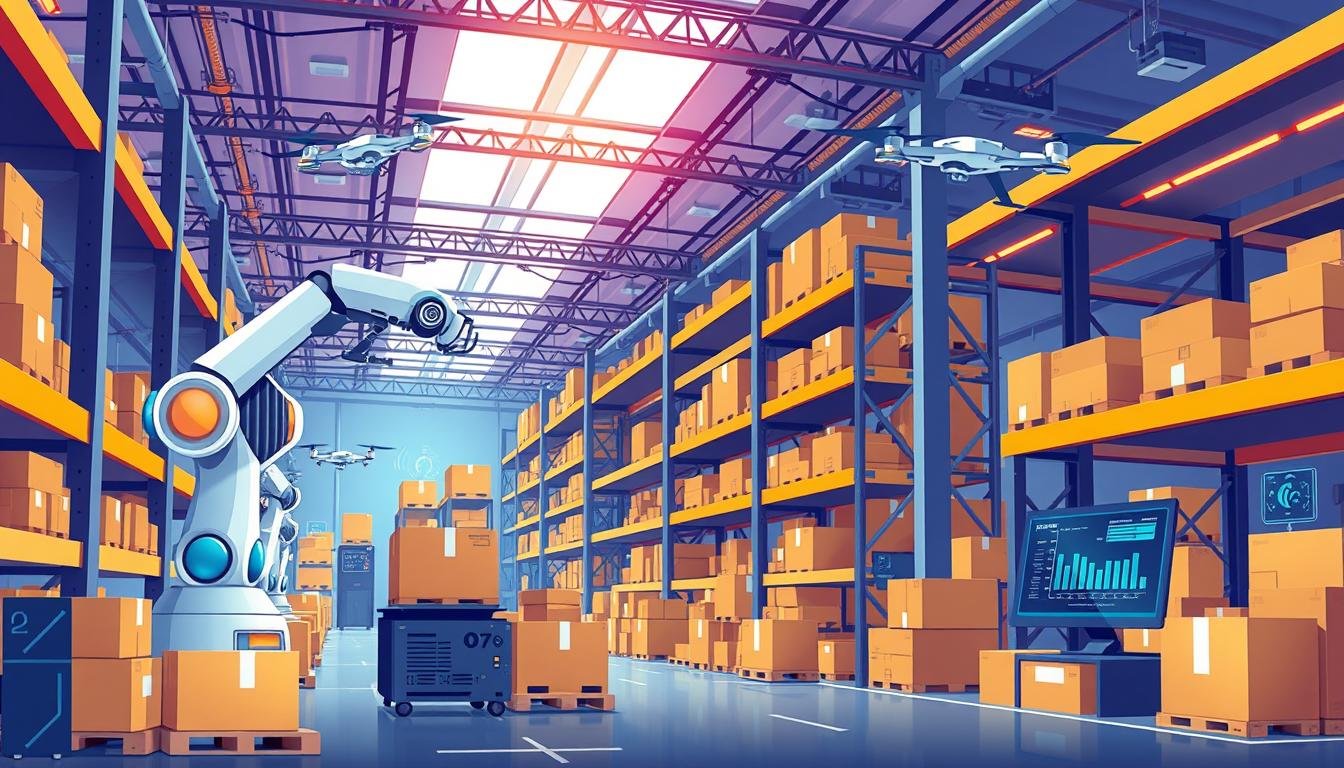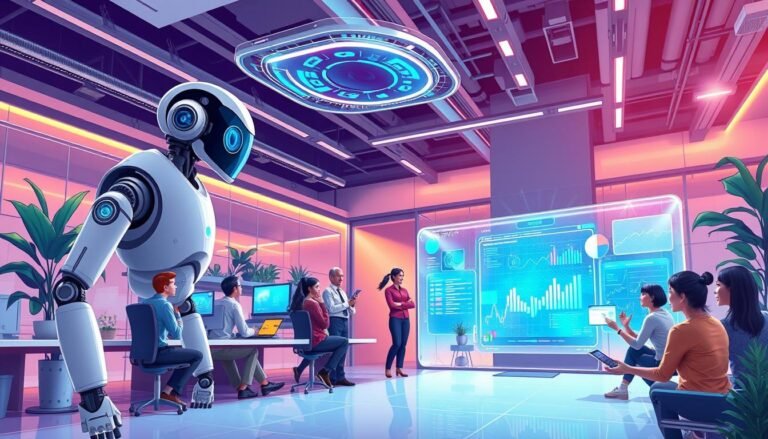AI in Supply Chain Optimization: Boosting Efficiency
Can artificial intelligence really change how we manage supply chains? This question is on everyone’s mind as companies look for new ways to work better and save money. AI is making big changes in supply chain management, bringing new chances for smarter logistics and better efficiency.
AI is changing how we do things in supply chains. It’s bringing in new tools like predictive analytics and automated decisions. This change is not just about using new technology; it’s about changing how we think about supply chains.
Studies show that companies with strong supplier relationships can lower risk of supply shortages by up to 35%. This big drop shows how AI can help avoid costly delays and save on shipping costs.
AI’s impact goes beyond just managing risks. By using Industry 4.0 tech like AI and robotics, companies have seen a 30% jump in production and a 25% boost in product quality. These numbers show how AI can really change supply chain efficiency.
Key Takeaways
- AI integration reduces supply shortage risks by 35%
- Industry 4.0 tech boosts production rates by 30%
- AI improves product quality by 25%
- Predictive analytics enable real-time optimization
- AI-driven automation enhances decision-making processes
- Intelligent logistics systems streamline operations
Introduction to AI in Supply Chain Management
AI is changing how businesses work. It uses advanced tech to make processes smoother and more efficient. Machine learning is key, helping with data analysis and making decisions.
Supply chain automation is getting better. AI can now do complex tasks like:
- Predicting demand with high accuracy
- Optimizing inventory levels in real-time
- Enhancing route planning for logistics
These changes are real and making a big difference. For example, AI can cut forecasting errors by up to 50%. This saves money and makes customers happier.
But, using AI in supply chains also brings new challenges. Companies need to invest in new tech and training. Still, the benefits are worth it. AI is making supply chains more reliable, quick, and efficient.
“AI is not just enhancing supply chains; it’s redefining what’s possible in global logistics and operations.”
Looking closer at machine learning in supply chains shows AI’s big impact. It’s not just a tool; it’s a major change in how we manage supply chains.
The Role of Machine Learning in Supply Chain Optimization
Machine learning is changing how companies run their supply chains. It makes operations more efficient and accurate.
Predictive Analytics for Demand Forecasting
Predictive analytics is a game-changer for demand forecasting. Tools like IBM Watson and Google Analytics analyze data from social media and surveys. This helps companies predict market trends and customer needs better.
Amazon is a great example of AI in demand forecasting. It uses AI to manage its inventory and cut costs. By looking at past sales and market trends, Amazon can guess future demand accurately.
Inventory Management with AI
AI is making inventory management better across industries. These systems use real-time data to keep inventory levels just right. This reduces waste and prevents stockouts.
- Reduces excess inventory
- Prevents stockouts
- Improves cash flow
- Enhances customer satisfaction
Route Optimization Using Machine Learning Algorithms
Machine learning is making logistics more efficient by finding the cheapest routes. This cuts down on fuel use, speeds up deliveries, and makes customers happier.
| Company | AI Application | Results |
|---|---|---|
| Walmart | Supply Chain Optimization | Significant cost savings, Improved customer satisfaction |
| DHL | Predictive Network Management | Enhanced route efficiency, Reduced delivery times |
| Amazon | AI-Driven Inventory Management | Reduced costs, Improved stock accuracy |
These examples prove that machine learning is key for businesses to stay ahead in today’s fast market.
AI-Powered Logistics Automation
AI is changing how we manage supply chains. It’s making warehouses, order processing, and delivery better. Companies using these tools see big gains in efficiency and sales.
AI helps cut down on mistakes and downtime in making products. For example, robots and AI can spot when equipment might break. This means less cost and better products.
In warehouses, AI makes tracking and planning shipments easier. It looks at data to figure out the best stock levels and when to send out orders. This leads to lower costs and happier customers.
“Intelligent logistics automation is not just about efficiency; it’s about creating a competitive edge in the market.”
AI is also making last-mile delivery better. Self-driving cars and drones are being tested for this part of delivery. They could make deliveries faster and cheaper. This is key as online shopping keeps growing.
For AI to work well, companies need to keep training their teams. It’s important for employees to know how to use new tech. This keeps plants running smoothly and gets the most out of AI.
- AI-driven inventory management reduces storage costs
- Predictive maintenance minimizes equipment downtime
- Autonomous vehicles improve last-mile delivery efficiency
- Employee training is crucial for successful AI implementation
As AI in logistics keeps getting better, it will bring more changes to managing supply chains. It will make things more efficient and open up new chances for businesses ready to use these technologies.
Enhancing Supply Chain Visibility with Cognitive Computing
Cognitive computing is changing how we see supply chains. It lets businesses track goods, manage stock, and improve processes right away. Let’s see how it’s making supply chain management better.
Real-Time Tracking and Monitoring
Real-time tracking is a big deal for companies now. Cognitive computing lets them watch their stock, shipments, and production at any moment. This means they can make fast decisions and solve problems before they get worse.
Risk Assessment and Mitigation
AI tools are key for spotting risks in today’s complex supply chains. They look at lots of data to find problems before they happen. With cognitive computing, companies can plan better to avoid risks and keep things running smoothly.
Supplier Performance Analysis
Cognitive computing makes it easier to check how suppliers are doing. It quickly sorts through big amounts of data to see who’s reliable, quality, and cost-effective. This helps businesses make better choices about who to work with and makes their supply chain more efficient.
| Aspect | Traditional Approach | Cognitive Computing Approach |
|---|---|---|
| Tracking | Manual, periodic updates | Real-time, continuous monitoring |
| Risk Assessment | Reactive, based on historical data | Proactive, predictive analysis |
| Supplier Analysis | Limited data processing | Comprehensive, data-driven insights |
Cognitive computing is getting better, and so is supply chain visibility. Companies that use it will have a big edge in today’s fast business world.
AI in Supply Chain Optimization: Key Benefits and Challenges
AI is changing how businesses run their operations. It uses advanced algorithms and machine learning to boost efficiency and cut costs. For example, AI can predict demand better, leading to better inventory levels and less waste.
Despite AI’s promise, challenges remain. Poor data quality can stop AI from working well. It needs lots of accurate data to function. Also, integrating AI with current systems is hard, taking a lot of time and effort.
AI offers both chances and obstacles. It can make processes smoother and help make better decisions. But, it needs experts to manage and keep it running. This lack of talent can slow down AI adoption in supply chains.
- Improved demand forecasting accuracy
- Enhanced inventory management
- Optimized transportation routes
- Real-time supply chain visibility
Despite these hurdles, the benefits of AI in supply chain optimization are big. Companies that use AI well can outdo their rivals. They’ll see better efficiency, lower costs, and happier customers.
Implementing Deep Learning for Demand Forecasting
Deep learning demand forecasting changes how we manage supply chains. It uses advanced neural networks to spot complex data patterns. This leads to accurate predictions of future demand.
Time Series Analysis with Neural Networks
AI time series analysis uses smart algorithms to review past data. These neural networks in supply chains find trends and patterns that humans might overlook.
Incorporating External Factors in Predictions
Today’s forecasting models look at more than just internal data. They also consider external factors like the economy, weather, and global events. This makes their predictions more accurate.
Improving Forecast Accuracy Over Time
Deep learning gets better with time. As more data is added, the models get more precise. This means their predictions get more accurate over time.
| Forecast Method | Accuracy | Data Processing Capability |
|---|---|---|
| Traditional Statistical Models | 70-80% | Limited |
| Machine Learning Models | 80-90% | Moderate |
| Deep Learning Models | 90-95% | Extensive |
The World Bank uses Vector Autoregression models for complex predictions. These models explain 78% to 99% of variable changes. This shows how AI can optimize supply chains.
Natural Language Processing in Supply Chain Planning
Natural language processing is changing how businesses manage their operations. It helps companies understand vast amounts of unstructured data. This includes customer reviews, supplier emails, and social media posts.
AI is making supply chain communication more efficient. Chatbots handle routine questions, freeing up humans for complex tasks. They also translate communications between global partners, breaking language barriers.
NLP predicts trends and issues before they become problems. It analyzes customer feedback and market data. This alerts managers to potential disruptions or opportunities.
“NLP is revolutionizing supply chain management by turning raw data into actionable insights,” says a leading industry expert.
NLP in supply chain planning is getting more advanced. We’ll see automated contract analysis and real-time supplier tracking. Companies that use this technology will thrive in the global market.
Case Studies: Successful AI Implementation in Supply Chains
AI supply chain case studies show how top companies use tech to get better. Let’s look at three examples of how AI makes supply chains more efficient.
Amazon’s AI-Driven Inventory Management
Amazon uses AI a lot for managing its inventory. It predicts demand with AI, which helps it keep the right amount of stock. This has cut down on extra stock by 10% and sped up order fulfillment by 5%.
DHL’s Predictive Network Management
DHL made its logistics better with AI. It cut down delivery times by 15% and fuel use by 20%. AI looks at traffic and weather to find the best routes.
Walmart’s Supply Chain Optimization with AI
Walmart uses AI to make its huge operations smoother. It predicts demand and manages inventory with AI. This has reduced stockouts by 7% and made the supply chain 3% more efficient.
| Company | AI Application | Key Results |
|---|---|---|
| Amazon | Inventory Management | 10% reduction in excess inventory |
| DHL | Route Optimization | 15% reduction in delivery times |
| Walmart | Demand Prediction | 7% reduction in out-of-stock items |
These examples show how AI changes supply chain management. They give insights for businesses wanting to improve with technology.
Future Trends in AI-Driven Supply Chain Management
The future of AI in supply chains is looking bright. New technologies are making AI systems smarter and more adaptable. These systems can learn and get better over time, keeping up with new data and tech.
Blockchain and IoT devices are becoming key players in the future. They will make supply chains more transparent and efficient. This combo will help make predictions more accurate and decisions faster.
AI is also getting better at managing entire supply chains. These advanced systems can handle complex tasks like planning and solving problems. This means big improvements in efficiency and cost savings for industries like manufacturing and logistics.
Looking ahead, we’re aiming for fully autonomous and self-optimizing supply chains. These AI systems will boost operations and make them safer and more secure. They’ll catch and fix problems quickly. The future of AI in supply chains is promising, with better accuracy, personalization, and performance.
Source Links
- Considerations for Building and Operating a Successful Manufacturing Plant
- Earnings call: Roots Corporation Q2 2024 sales dip, debt reduction on track By Investing.com
- Stem (STEM): Hedge Funds Are Bullish On This Green Energy Penny Stock Now
- Clean Energy Fuels (CLNE): Hedge Funds Are Bullish On This Green Energy Penny Stock Now
- Gevo (GEVO): Hedge Funds Are Bullish On This Green Energy Penny Stock Now
- Startup of the Week – US-based SambaNova sets sights on Saudi market
- Leveraging AI for Effective Business Planning – INSCMagazine
- The 12 Biggest Tech Companies by Market Cap: Industry Titans
- Streamlining the Customer Experience to Maximize Revenue: A Strategic Guide for Chief Revenue Officers
- The Role of Digital Supply Chain on Inventory Management Effectiveness within Engineering Companies in Jordan
- Real-Time Fire Detection: Integrating Lightweight Deep Learning Models on Drones with Edge Computing
- Hybrid Quantum-Classical Machine Learning Models: Powering the Future of AI
- Advanced Queueing and Location-Allocation Strategies for Sustainable Food Supply Chain
- Overview of Startups Developing Artificial Intelligence for the Energy Sector
- Unlock AWS Cost and Usage insights with generative AI powered by Amazon Bedrock | Amazon Web Services
- AI is Redefining the Light Rail Market, Revenue to Grow by USD 3.74 Billion from 2024-2028 Due to Urban Expansion – Technavio Report
- How Manufacturers Can Use Governed Data and AI for Operational Excellence
- Preliminary Design of Satellite Systems through the Integration of Model-Based System Engineering and Agile Methodologies: Application to the 3ColStar Mission
- Adaptive AI Development: An Ultimate Guide For 2024
- 3D Printing Webinar and Event Roundup: September 14, 2024 – 3DPrint.com | The Voice of 3D Printing / Additive Manufacturing







